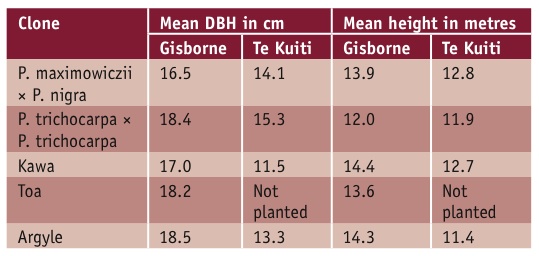Where is poplar and willow research going?
Ian McIvor, New Zealand Tree Grower November 2007.
New Zealand has developed unique and innovative systems for using poplars in soil conservation on slopes which continue to impress overseas visitors. The need to stabilise our hill country has dominated the direction in which poplar research has been applied. Similarly the need to stabilise our riverbanks has dominated the direction of willow research. However, other uses have always considered, in particular shelter, fodder and timber. Breeding programmes have developed clones suitable to most climatic zones across New Zealand, and landowners have a range of choices when selecting poplars for soil conservation, shelterbelts or timber.
Poplar research will continue to develop a versatile range of multi- purpose clones to provide resilience to new incursions of pests and diseases and a changing climate. The choices for the future in tree willows will increase, though not as many as for poplars.
Root development
In addition to breeding new clones, there are several research areas that are currently being addressed. Considerable effort is going into researching root development in poplars planted from poles on hill slopes. Very few studies on poplar root development have been done internationally, primarily because it is a very arduous and labour intensive task.
However one of the most frequently asked questions about poplars being raised by landowners is how extensive the roots are.
The table below gives some indication that Veronese poplar trees planted from poles take a long time to develop an extensive root system. Obviously the root system five years after the pole was planted is sufficient for the growing needs of the tree, but may well be insufficient to anchor the tree on the slope if the slope were to become saturated. They will certainly struggle to hold the slope from slipping unless supported by close planted neighbouring trees.

Other poplar clones are not expected to be too different, but this is by no means certain.
How close to plant poplars
Another question that is frequently asked by land managers is how close poplar trees have to be planted to prevent soil slippage. The answer to this is that it depends.
Scientists from AgResearch and HortResearch have been collating information to answer this question by visiting farm sites where poplars have been planted for 7 to 30 years. At these sites scientists have been measuring poplar tree diameter at breast height, distances to neighbouring trees and distances to any nearby slips. They expect that this will give an answer to this frequently asked question.
In a recently completed Sustainable Farming Fund project the Poplar and Willow Users Group researched and reported on poisoning of large poplars past their use-by date. Some rust resistant clones planted for soil stabilisation in the 1970s and 1980s have developed large canopies which shade pasture and heavy branches are prone to splitting. Poisoning is a relatively safe way of killing these old large trees, although these trees need to be replaced to continue slope protection.
Future research is investigating pollarding as a means of controlling size in soil conservation poplars and willows. This research will focus on the effects on the root development of pollarding poplars at regular intervals of three to four years. Pollarded trees shade pasture a lot less than fully canopied trees, so these trees can be planted closer together. Pollarding offers an alternative to thinning as trees continue to grow, but any effects on the roots need to be determined if they are to stabilise slopes as effectively.
Clones for timber
A fledgling market for poplar timber within New Zealand has meant that most poplar sold as timber has gone to China, though local sources have supplied the pulp industry. Research on the aspects of poplar important for the timber industry have lagged behind research focussed on soil conservation. Limited funding is available and support for poplar research has come from regional authorities.
Several experimental clones of P. trichocarpa × P. trichocarpa and several P. maximowiczii × P. nigra are being evaluated together with the already released clones Kawa, Toa and Argyle for performance as timber trees. These are two close-spaced trials established in 1998 on fertile land, one in Gisborne and one near Te Kuiti. These trials will run until 2013. Growth data from the trials measured in March, 2003 is given in the table.

Fodder and worm protection
Recognition of the usefulness of willow as a summer drought fodder and possible anthelmintic has been demonstrated through recent research done at Massey University and publicised through a Sustainable Farming Fund project. Establishing a willow fodder block in a damp corner of the farm has been shown to be a very effective way of bringing an unproductive area of land into production. The willows dry out the ground and provide a fodder high in metabolisable energy and high in tannins, which may be the effective agents in reducing worm loads in sheep.
Finally a research project at Clydevale in South Otago is investigating the use of Kinuyanagi shrub willows in nutrient stripping of dairy shed effluent applied to pasture to reduce runoff and leaching into waterways. Initial results are promising, but further work is required to understand how to best manage the system to use fodder production and nutrient stripping components.

 Farm Forestry New Zealand
Farm Forestry New Zealand